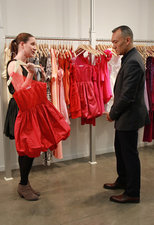Giving Your Business a Reality Check
I have a confession to make. My name is Caletha Crawford, and I’m a TV addict. And while my slavish devotion to my DVR means I’ve seen every episode of “Mad Men”, “ABC World News” and “Charlie Rose,” I can’t pretend that mine is a highbrow problem. No, I’ve been known to wallow in the crack of programming known as reality television. If there was a “housewife” raving and conniving or a “survivor” swallowing bugs (and conniving), I was there front and center, taking it all in all the while mourning the brain cells I was sentencing to an early death. Readers, actual crack might have been healthier. But thanks to a moment of clarity, I finally snapped out of my stupor and quit cold turkey — trashy reality shows, not TV altogether. But as any addict will tell you, getting one monkey off your back leaves space for another one to hop right on. And this time, I’m not just the addict; I’m also the pusher. So I invite you to join me in my new obsession: reality shows that teach and inform. Yes, I know that sounds like an oxymoron like healthy bacon, but they do exist.
These days I can’t get enough of programs like “Shark Tank”, “America’s Next Great Restaurant” and “All on the Line,” which place entrepreneurs on the hot seat. These shows actually push two buttons with me — the aforementioned TV thing and my love of small business. While watching, I often find myself nodding along with the advice the experts dole out. Though the formats vary, each focuses on an individual with an idea or startup operation who is looking for the investment or expertise they need to launch or grow. The edutainment factor makes the lessons palatable and much easier to absorb than all those business tomes gathering dust on the nightstand.
Is Your Brand “GMC” or “Special”?
In “All on the Line,” the newest entrant in this format, Elle magazine’s creative director Joe Zee mentors one fledgling, flailing designer (or design team) each week. While there are a few eye-roll inducing reality-show conceits built into the format of this Sundance Channel series, Zee’s sage advice could help you strengthen your own collections. For instance, in one episode, Zee takes former “Project Runway” alum Kara Janx under his wing in an effort to reboot her line. The first order of business was to overhaul what Zee termed her GMC or generic mall clothes. His critique of her utterly forgettable collection stood as a good reminder for designers that you have to have a point of view — an angle to your designs and marketing that’s fresh, exciting and uniquely you. Remember, in the better market, “special” is what sells. It’s a point for retailers to consider too. After all, your customers can buy basics anywhere. So, does your merchandise rise above GMC?
Knowing Your Customer Is Not the Same as Knowing Your Own Child
Next, Zee forced Janx to conduct an impromptu consumer roundtable to determine what her target audience wants. It turned out to be an enlightening exercise for Janx who had clearly been out of touch with her consumer. Do you really know what your customers want? Or are you basing your selection on the things that make your little girl happy? While it’s nice to have your own focus group at home, it’s essential to understand what other moms think about the fabric, fit and fashion quotient in your line.
Evolve What Works Rather Than Risk Losing Customers
Finally, Zee convinced Janx to embrace the look that retailers and consumers love from her. Because she’d been selling the same kimono-style dress since her first go-round with reality TV, Janx was bored with the look and had abandoned it. Zee helped her understand that evolving it further was the better business decision. Once she embraced the idea of new fabrics, patterns and silhouette tweaks, Janx was left with a capsule collection that spoke to her target consumer and appealed to retailers. The lesson? Though you might have to suppress a scream every time you fill an order for that duck print that just won’t die or the bows that seem to have a life of their own, the reality is these goods keep your lights on. Why not evolve the concepts rather than risk abandoning existing customers? A study by Marketing Metrics found the average company has a 60 to 70 percent probability of selling again to existing customers but only a 5 to 20 percent chance of selling to a prospect. The bottom line? Keep your current customers happy.
On ABC’s “Shark Tank,” it’s the millionaire investors asking the questions. On this show, business owners pitch their ideas to the millionaires (the eponymous “sharks”) in an attempt to secure funding for growth. While it’s fun to sit back and marvel at some of the outrageous ideas that come up like pogo sticks on steroids and a glorified rubber band designed to hold your cash, the real draw is watching the sharks’ rapid-fire queries, which illustrate how investors evaluate an idea or operation. In short order, they want to know about your business model, margins, annual sales figures, growth potential and the brand’s distinction from competitors.
On a recent show, a flight attendant introduced a Ride-On Carry-On, a chair that straps onto luggage so that parents don’t have to drag their bags while pushing a separate stroller. The sharks posed all of the usual questions to her and ultimately decided the idea had potential. But as is often the case, they disagreed on whether the business owner should bother with wholesale or simply license the idea to a luggage company. In the end, she got the $50,000 she was looking for to continue to make and distribute the product because she had a patent, a clean safety record and could show potential for earnings down the line.
Next time you tune in, pose the same questions to your own business. You might discover some strengths and weaknesses in your business model. Just don’t blame me if you find yourself glued to the tube for hours on end. Just know that I’m right there with you. After all, you know what they say, once an addict, always an addict. So tweet me @caletha_style and let me know what you think of my new preoccupation.
About Caletha Crawford
The Giggle Guide™ is pleased to welcome Caletha Crawford as a contributor to our “Business Sense” feature. Her industry experience, journalism expertise and candid opinions about challenges and solutions for small businesses are sure to be of interest and value to children’s retailers, manufacturers and service providers.
Caletha Crawford is an expert in the children’s apparel, accessories and gift industries. Her career has been focused on the business and fashion trends that drive this segment of the garment industry, most recently as the editor-in-chief of Earnshaw’s magazine. There, she kept readers abreast of contemporary market concerns, providing them with invaluable insight into how the industry was evolving and challenging them to reevaluate their strategies. Her keen market analysis has influenced prominent players to adopt new business practices and update product selections.
Caletha continues her commitment to aiding emerging design talent through her role as part-time faculty at Parsons The New School for Design. She also writes frequently for a variety of publications, assists companies with their PR efforts and consults with apparel and accessories businesses on branding, launch strategies and marketing.
For more information, visit www.calethacrawford.com or email .













